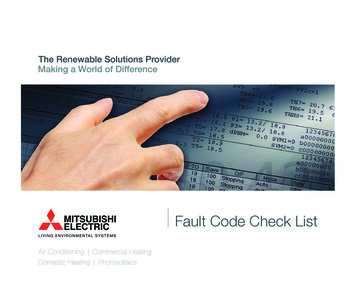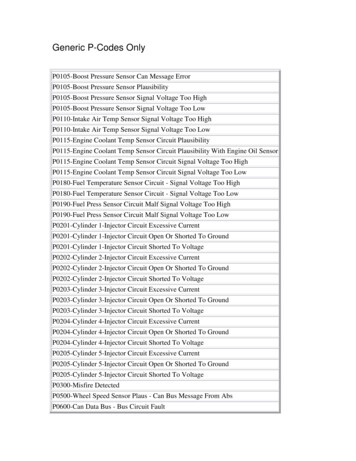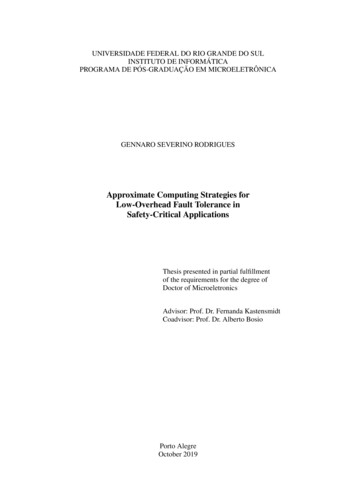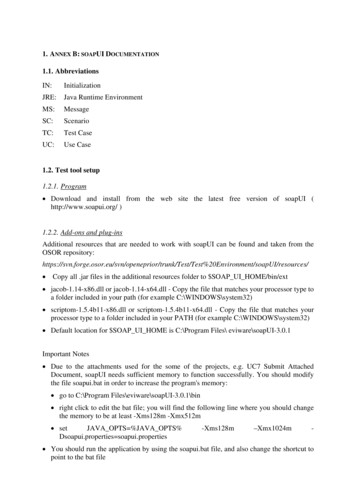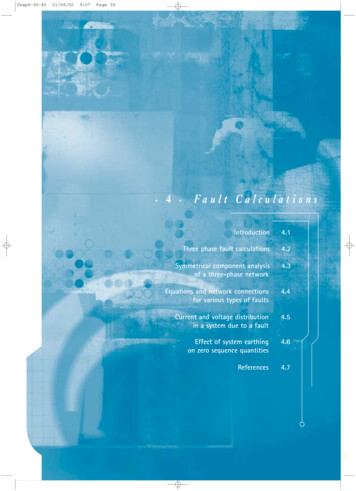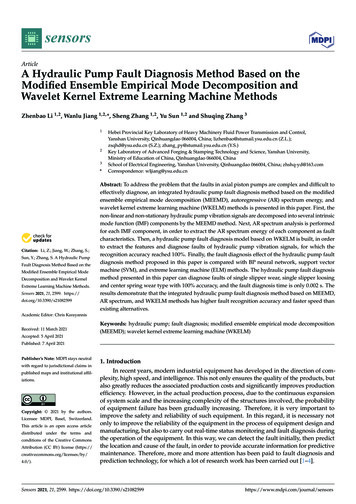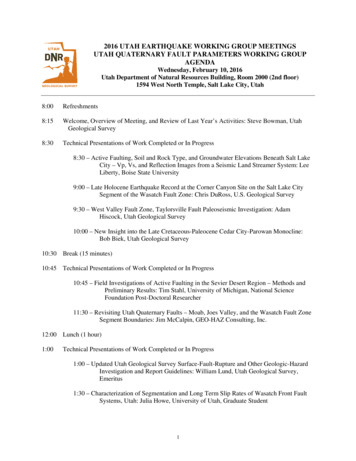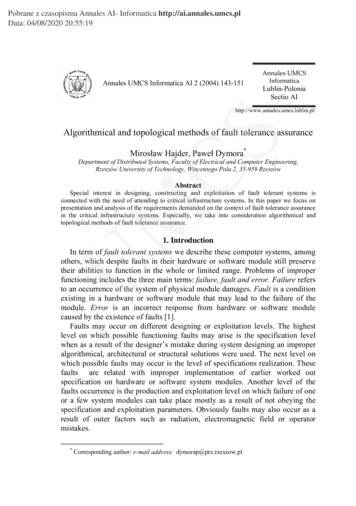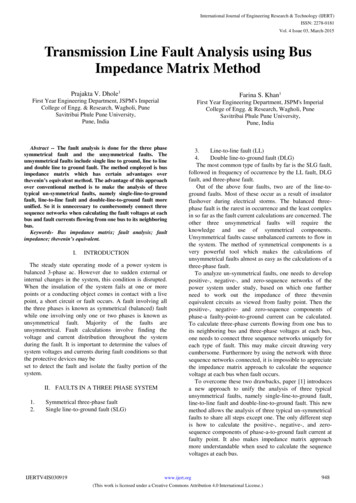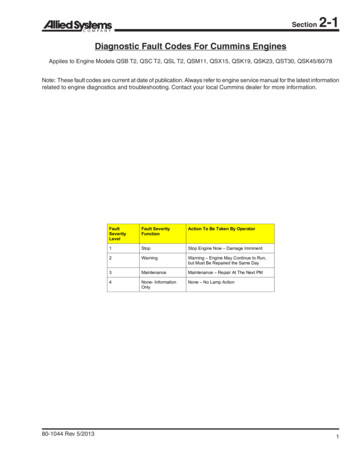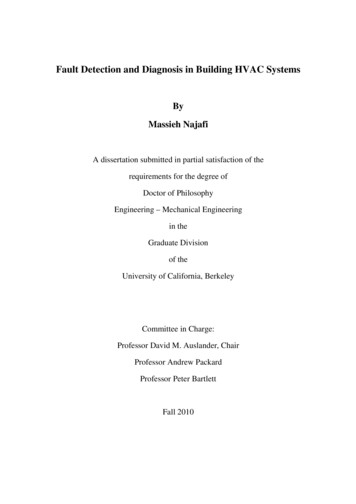
Transcription
Fault Detection and Diagnosis in Building HVAC SystemsByMassieh NajafiA dissertation submitted in partial satisfaction of therequirements for the degree ofDoctor of PhilosophyEngineering – Mechanical Engineeringin theGraduate Divisionof theUniversity of California, BerkeleyCommittee in Charge:Professor David M. Auslander, ChairProfessor Andrew PackardProfessor Peter BartlettFall 2010
iABSTRACTFault Detection and Diagnosis in Building HVAC SystemsbyMassieh NajafiDoctor of Philosophy in Mechanical EngineeringUniversity of California, BerkeleyProfessor David M. Auslander, ChairBuilding HVAC systems account for more than 30% of annual energy consumption in UnitedStates. However, it has become apparent that only in a small percentage of buildings do HVACsystems work efficiently or in accordance with design intent. Studies have shown thatoperational faults are one of the main reasons for the inefficient performance of these systems. Itis estimated that an energy saving of 5 to 15 percent is achievable simply by fixing faults andoptimizing building control systems.In spite of good progress in recent years, methods to manage faults in building HVAC systemsare still generally undeveloped; in particular, there is still a lack of reliable, affordable, andscalable solutions to manage faults in HVAC systems. Modeling limitations, measurementconstraints, and the complexity of concurrent faults have made the diagnosis of these problemsas much an art as a science. The challenge is how to evaluate system performance within theboundaries defined by such limitations.This thesis focuses on a number of issues that, in our opinion, are crucial to the development ofreliable and scalable diagnostic solutions for building HVAC systems. Diagnostic complexitydue to modeling and measurement constraints, the pro-activeness of diagnostic mechanisms,bottom-up versus top-down diagnostic perspectives, diagnosis-ability, and the correlationbetween measurement constraints and diagnostic capability will be discussed in detail.We will develop model-based and non-model-based diagnostic algorithms that have thecapability of dealing with modeling and measurement constraints more effectively. We willshow how the effect of measurement constraints can be traced to the information entropy ofdiagnostics assessments and how this can lead to a framework optimizing the architecture ofsensor networks from the diagnostic perspective.
iiIn another part of this study, we focus on proactive diagnostics. In the past, the topic of proactivefault diagnostics has not been given enough attention, even though the capability of conductingand supervising automated proactive testing is essential in terms of being able to replace manualtroubleshooting with automated solutions. We will show how a proactive testing problem can beformulated as a decision making problem coupled with a Bayesian network diagnostic model.The algorithms presented in this thesis have been implemented and tested in the LawrenceBerkeley National Laboratory (LBNL) using real and synthetic data.
iiiDEDICATIONI dedicate this work to my wife Iman and my parents. No words will ever express how grateful Iam to them.
ivTABLE OF CONTENTSABSTRACT . IDEDICATION. IIIACKNOWLEDGEMENT . VI1. INTRODUCTION . 11.11.21.31.4Modeling limitations and measurement constraints . 2Bottom-up versus top-down diagnostics . 5Proactive fault diagnostics . 7Quantification of measurement constraints’ impact on diagnostics capability . 82. BAYESIAN NETWORK BASED DIAGNOSTIC FRAMEWORK. 92.12.2Bayesian Network Based Diagnostic Mechanism . 9Diagnostics of Mixture of Components . 163. PROACTIVE FAULT DIAGNOSTICS . 213.13.23.3Introduction . 21Proactive Fault Diagnostic Mechanism . 22Proactive Testing of Air Handling Unit . 244. A STATISTICAL PATTERN ANALYSIS APPROACH FOR ROOFTOPUNIT DIAGNOSTICS . 274.14.2Introduction . 27Proactive Testing of Air Handling Unit . 284.2.14.2.24.34.44.5Cooling/Heating System Diagnostics . 28Mixing box diagnostics . 35Proactive Testing of Air Handling Unit . 39Proactive Testing of Air Handling Unit . 39Proactive Testing of Air Handling Unit . 395. BOTTOM-UP VERSUS TOP-DOWN DIAGNOSTICS . 405.15.2Top-down Automated Diagnostics . 41Illustrative Example: Diagnostics of an Office Building. 436. MEASUREMENT CONSTRAINT AND DIAGNOSTIC CAPABILITY . 50
v6.1 A Framework for the Quantification of the Impact of Additional Measurementon Diagnostic Capability . 506.2 Illustrative Example: Analyzing the Impact of New Measurement on an OfficeBuilding’s Diagnostics . 527. CONCLUSION . 638. REFERENCE . 66
viACKNOWLEDGEMENTThis work could not have been completed without the guidance and supervision of ProfessorDavid M. Auslander, Professor Peter Bartlett, Professor David R. Brillinger, Dr. Philip Haves,and Dr. Mike Sohn, to whom I owe most of this accomplishment. I also acknowledge the veryhelpful assistance and review from Professor Andrew Packard. The continual support andinspiration I received from them made all efforts worthwhile.This work was supported in part by the Assistant Secretary for Energy Efficiency and RenewableEnergy, Office of Building Technology, State and Community Programs of the U.S. Departmentof Energy under Contract No. DE-AC02-05CH11231; by the California Energy CommissionPIER Buildings program through the California Institute for Energy and the Environment(CIEE); and by Laboratory Directed Research and Development (LDRD) funding from BerkeleyLab, provided by the Director, Office of Science, of the U.S. Department of Energy underContract No. DE-AC02-05CH11231.Disclaimer: This document was prepared in part on an account sponsored by the United StatesGovernment. While this document is believed to contain correct information, neither theUnited States Government nor any agency thereof, nor The Regents of the University ofCalifornia, nor any of their employees, makes any warranty, express or implied, or assumesany legal responsibility for the accuracy, completeness, or usefulness of any information,apparatus, product, or process disclosed, or represents that its use would not infringe privatelyowned rights. Reference herein to any specific commercial product, process, or service by itstrade name, trademark, manufacturer, or otherwise, does not necessarily constitute or imply itsendorsement, recommendation, or favoring by the United States Government or any agencythereof, or The Regents of the University of California. The views and opinions of the authorexpressed herein do not necessarily state or reflect those of the United States Government or anyagency thereof or The Regents of the University of California.This report was also prepared in part as a result of work sponsored by the California EnergyCommission (Energy Commission) and the University of California (UC). It doesnot necessarily represent the views of the Energy Commission, UC, their employees, or the Stateof California. The Energy Commission, the State of California, its employees, and UC make nowarranty, express or implied, and assume no legal liability for the information in this report; nordoes any party represent that the use of this information will not infringe upon privately ownedrights. This report has not been approved or disapproved by the Energy Commission or UC, norhas the Energy Commission or UC passed upon the accuracy or adequacy of the information inthis report.
11. INTRODUCTIONThe operation of building HVAC systems accounts for more than 30 percent of annual energyconsumption in United States [1, 2]. However, it has become apparent that only in a smallpercentage of buildings do HVAC systems work efficiently or in accordance with the deignintent [3, 4]. Studies have shown that operational faults are one of the main reasons for theinefficient performance of these systems. It is estimated that an energy saving of 5 to 15 percentis achievable simply by fixing faults and optimizing building control systems [5].Current methods for detecting faults or performance creep in building HVAC systems are laborintensive. Typically, building operators or engineers use intuition and various rules of thumb toidentify the problem. In practice, the labor-intensiveness of these tasks is such that they are notroutinely performed, and they may never be performed in most buildings. If the achievable 5 to15 percent energy savings are to be met in practice, building energy management systems mustbe capable of detecting when a failure has occurred or when performance is creeping, and beable to determine the likely offending hardware or operating condition. Automated systems forfault detection are therefore essential if low-energy or net zero energy goals are to be metnationally.The topic of automated fault detection and diagnosis (FDD) has been an active area for researchand development in applications such as aerospace, process control, automotive, andmanufacturing over the past four decades [6-17]. In building HVAC systems, FDD has receivedincreasing attention over the last decade or so [18, 19]. A variety of diagnostic methods fromfirst-principle-model-based approaches [20-23] to empirical-model-based approaches [24-34]and qualitative/rule-based approaches [35-42] have been developed by researchers toautomatically detect and isolate faults in HVAC systems: air handling units [22, 40, 43-48],chillers [23, 49-53], heat pumps [54-55], and others.In spite of good progress in recent years, methods to manage faults in building HVAC systemsare still generally undeveloped; in particular, a lack of reliable, affordable, and scalable solutionsto manage faults in HVAC systems still exists. A variety of reasons, from technical barriers tofinancial motivations and regulatory obstacles, account for the absence of widespread availabilityand deployment of FDD systems [19]. From a technical standpoint, which is the focus of thisthesis, modeling limitations, measurement constraints, and diversity and multiplicity of faultshave made the problem significantly more complex.In this thesis, we focus on a number of issues that in our opinion are crucial to the developmentof reliable, affordable, and scalable solutions. Diagnostics complexity due to modeling and
2measurement constraints, proactiveness of diagnostic mechanisms, transition from bottom-up totop-down automated diagnostics, and the correlation between measurement constraints anddiagnostics capability are the subjects that we will discuss in detail, and will also suggest somesystematic solutions.1.1 Modeling limitations and measurement constraintsOne of the main challenges in building HVAC diagnostics is modeling limitations. Theprinciples of HVAC equipment are known well enough to create a suitable model structure.However, from a widespread availability and deployment perspective, the accuracy of thesemodels can be improved up to certain levels. Beyond that, extensive effort is required to obtainhigh-quality a priori knowledge1 that affects the scalability attribute. This limits the applicabilityof diagnostic solutions that depend on highly accurate or detailed models. Such models requirean extensive amount of configuration data that may not be available or measurable in practice.On the other hand, when the focus leans toward less accurate models, either by using simplifiedfirst-principle models or empirical models with some level of uncertainty, the new challenge thenbecomes how to differentiate inconsistencies (the difference between system outputs and modelpredictions) that arise from modeling errors and system faults.One way to deal with such complexity is to change the diagnostic focus to behavioral patternsinstead of residuals. In other words, instead of analyzing a system’s performance by comparingthe difference between the outputs and model predictions at one or a few operating points,diagnostics is achieved by evaluating the system behavior pattern over a window of operation.This strategy has been used in some diagnostic methods, especially qualitative and semiquantitative approaches [1-4]. The key here is an inference mechanism to match the observedbehavior from the system with a set of predefined or even new hypotheses in an environmentaffected by noise and uncertainty.Fuzzy logic has turned out to be a popular choice for these types of problems. The inherentflexibility embedded in fuzzy sets and fuzzy rules make it a suitable solution for reasoning indomains affected by uncertainty and error. In building HVAC systems, fuzzy-based diagnosticmechanisms have been used in several studies [21, 56, 57, 58]. For example, in [57], Haves et al.have developed fuzzy-based diagnostic routines for fault detection and diagnosis of VAV airhandling units. In their proposed approach, fuzzy-based inference mechanisms compare system1If the model is a detailed first-principle model, the a priori knowledge is mainly model parameters values andtheir variations. If the model is an empirical model, the a priori knowledge is usually high-quality training data ofthe system behavior in different modes.
3outputs with the predictions of simplified models at various operating points to draw conclusionsabout the system health status.However, fuzzy-based inference mechanisms have their own limitations. As the problemcomplexity grows (due to the system complexity, large number of disparate sensor data, andmany possible faults, etc.), a prohibitive number of fuzzy sets and fuzzy rules are required forsystem diagnostics. Added to this is the issue of adjusting and tuning fuzzy sets either manuallyor through other approaches.It is worth mentioning that another way of dealing with modeling limitations in HVACdiagnostics is rule-based diagnostics [20-34]. In this approach, the a priori knowledge isformulated through a set of if-then-else rules, and an inference mechanism searches through therule-space to draw conclusions. Rule-based systems can be based on expert knowledge or firstprinciples. The strength of rule-based systems is ease of development and the ability to reasonunder uncertainty. However, as it has been discussed in [18], as the problem complexity grows orwhen new rules are to be added, the simplicity of rule-based systems is lost quickly.Furthermore, sometimes the activation of the rules depends on threshold(s) that may highlydepend on model uncertainties, measurement errors, or other issues. More discussion on this canbe found at [40].Another challenging issue in building HVAC diagnostics is measurement constraints. In buildingHVAC systems, sensor network architectures are not necessarily designed solely based ondiagnostic purposes. Other factors such as controls, financial constraints, and practicallimitations are also involved. As a result, it is common to have one or more components beingmonitored through only one sensor (or one set of sensors). In such a scenario, when the sensoroutput is contaminated, it could be due to the malfunctioning of any of the involved components,and it may not be a straightforward task to locate the affected one. In other words, the problemcomplexity expands from the diagnostics of one component to a network of components.An example of this is the air-handling unit. As will be discussed in Chapter 2, in air-handling androoftop units, there is usually no reliable measurement of the mixed air temperature due to theincomplete upstream mixing. This results in using the downstream supply-air temperature toinfer the performance of both the mixing box and the heating/cooling coils (Figure 1.1). In otherwords, the functionality of three components is monitored through only one sensor.In general, the complexity of diagnostic problems due to measurement constraints has not beenaddressed in a systematic fashion or in much detail. Most methods reported in the literatureassume that either the required measurements are available, or a unique solution exists that issufficiently described by existing measurements.
4Return Air TempSensor (RAT)Exhaust AirReturn AirActuatorRADThoThoSupply FanOutside AirSupply AirOADOutside Air TempSensor (OAT)Mixing BoxThiThiCoolingCoilHeatingCoilSupply Air TempSensor (SAT)Figure 1.1: Air-handling unit schematic diagramA part of our focus in this study is to develop diagnostic algorithms that can systematically dealwith modeling and measurement constraints. In Chapter 2, we present a Bayesian network-baseddiagnostic mechanism that analyzes a system’s performance by evaluating the behavioralpatterns over a window of operation and comparing them with various hypotheses. Eachhypothesis is indeed a predicted performance of the system (developed by simplified models)under the assumption of one or more faults. We will demonstrate how the framework can besystematically expanded as the problem complexity grows.Another attribute of the proposed mechanism is its capability to deal with measurementconstraints. As it will be shown in Chapter 2, the missing measurements can be formulated ashidden variables in the Bayesian model.In Chapter 4, we present another diagnostic approach, a model-free approach, for rooftop units.The approach evaluates rooftop unit performance by analyzing the correlation among parametersand matching them with various predefined patterns without using any model. We willdemonstrate the effectiveness of the method by testing it with data coming from different retailstores.
51.2 Bottom-up versus top--down diagnosticsFault detection and diagnostics in building HVAC systems can be approached from twoperspectives: bottom-upp and top-downtopperspectives [59]. In the bottom-upup approach, lower-level2performance measures of HVAC systems (Figure 1.21.2) are used to isolate the problem andpropagate its effect on building performance. ConversConversely, in the top-downdown approachapproach, higher-levelperformance measures are used to reason about possible lower-levellower level causes of degradation to thehigher-level measures.Bottom-up diagnostic routines are usually initiated by complaints from the occupants.occupant Whenoccupants complain about a hot, cold, or uncomfortable environment, a diagnostic routine on thearea related to the complaint is begun to trace the problem and locate the malfunctioningmalfunctiondevice.In contrast, top-downdown diagnostic processes, which are also known as whole building diagnostics,are normally motivated by a concern for efficient building operation. When, for example,building energy usage increases unexpectedly, a toptop-down diagnosticostic process is performed tolocate the inefficient division/section and trace the problematic device or cause.Figure 1.2: Top-downTopand bottom-upup diagnostic approaches for building HVAC2Figure 1.2 is borrowed from [59].
6In recent years, there has been growing interest in top-down diagnostic approaches [60-64]. Partof this is due to growing concerns about building efficiency. Another reason is measurementflexibility. Top-down diagnostic processes are usually based on monitoring the energy consumedby the building and/or subsystems (e.g., cooling/heating systems, fans, lights, etc.), which ismeasured indirectly by monitoring the amount of electricity or gas provided to the building (orsubsystem). This is an easier way of measuring energy usage than the direct way of measuringstate parameters such as temperature, pressure, or other indicators to calculate the energy usage.From an automated diagnostics perspective, a wide range of research studies has been performedfor the automation of bottom-up diagnostic processes [18, 19]. However, for top-downdiagnostics, the story is different: building-level diagnostic processes are still performedmanually, in which building experts analyze the performance graphs, looking for predefinedsignatures to detect and isolate abnormalities [59, 60, 61]. In more advanced cases, a buildingmodel (developed by DOE2, Energy Plus, etc.) is used as a rough reference as well [63, 64].When diagnostics is to be achieved at the building level, the problem complexity extends to anew horizon. At the component level, there is a small set of faults to deal with, while at thebuilding level, a massive number of faults need to be managed. Added to this is the complexityof concurrent faults, which expands the set of abnormal scenarios exponentially. Another issue isfault detectability. All building HVAC faults are not necessarily detectable through high-levelmeasures. The impact of some faults may not be differentiated from modeling and measurementerrors. For example, it is very unlikely to be able to detect the effect of a damper leakage or stuckdamper fault on the total energy used by a four-story building. The challenge is that there is nosystematic framework to differentiate between detectable and non-detectable faults. In otherwords, there is no standard routine for evaluating available measures to determine which faultsshould be included and which ones should be removed from the diagnostic process.These challenges are the main barriers to the automation of building HVAC diagnostics from atop-down perspective. The extensive number of faults and the complexity of fault detectabilitylimit the applicability of conventional diagnostic approaches. In this study, we approach theproblem in a different way. We extend the Bayesian network diagnostic model, presented inChapter 2, to whole building-level diagnostics and employ numerical routines to manage theproblem complexity. In Chapter 5, we demonstrate how the proposed diagnostic solution caneffectively analyze building performance from a top-down perspective and how the limitation offault detectability influences diagnostic results.
71.3 Proactive fault diagnosticsMost research studies on fault detection and diagnosis in building HVAC systems have focusedonly on one side of the problem: analyzing system outputs for diagnostics purposes. Fewerstudies have addressed the other side of the problem: manipulating system inputs for betterdiagnostics. In other words, the question of how diagnostic mechanisms can supervise systeminputs for diagnostic purposes is still open. If the aim of automated diagnostics is to replacemanual troubleshooting with automated tools, FDD mechanisms should be capable ofsupervising system inputs for comprehensive or targeted tests, especially when it comes tocommissioning and functional testing. The feedback control loop may never generate enoughexcitation of the system inputs to explore broadly enough for a complete diagnostic analysis. Theability to supervise and manage automated diagnostic tests would extend diagnostic toolcapabilities into a new horizon.Conventional approaches for proactive testing are mainly based on predefined tests [21, 57, 58,65-68]. Researchers and engineers with a sufficient understanding of system dynamics designtest sets or test sequences as the standard for comprehensive or targeted diagnostic assessment.This concept has been pursued in HVAC systems as well [57, 58, 67, 68]. For example, in [67,68], Katimamula et al. have developed decision-tree-type test procedures to proactively analyzethe functionality of hot water and cold water valves in air-handling units. In another studies [57],Haves et al have developed test procedures to analyze the functionality of mixing box, fan, andheating/cooling coils in air-handling units.One drawback of predefined test-based approaches is the lack of flexibility and adaptability.Usually, these tests are structured to check the existence of one (or more) fault(s) at each step (orsubset of steps). For example, in order to check for an outside air damper leakage fault in amixing box, the damper is commanded to a fully closed position to see whether the dischargeand return air temperatures are equal. However, due to the uncertainties arising from modelinglimitations, measurement constraints, etc., the diagnostic mechanism may not be able toconclusively confirm a fault status based on one or two measurements. As a result, at the end ofthe test cycle, a substantial level of uncertainty may still remain in the diagnostic assessment.In addition, when these tests are to be performed in an orderly fashion, which is true in mostapplications, there is not that much space for adaptability. In other words, there is no systematicroutine to adjust and modify test sequences based on the diagnostic assessment at each step.These limitations apply to both Haves’ and Kapipamula’s frameworks.Another part of this study is to develop systematic frameworks for proactive diagnostics. Wethink of a proactive testing problem as an optimization problem in which an optimum path fromthe current state (the current diagnostic assessment) to the final state (a diagnostic assessment
8with minimum uncertainty) needs to be found. In Chapter 3, we show how such an optimizationproblem can be formulated as a decision-making problem, coupled with a Bayesian networkbased diagnostic mechanism.1.4 Quantification of measurement constraints’ impact on diagnostics capabilityAs mentioned previously, measurement constraints can expand the complexity of buildingHVAC diagnostic problems significantly. An important question to ask is how the relationshipbetween measurement constraints and diagnostic capability can be quantified systematically.Solving this problem will open new horizons in building HVAC diagnostics. It can be used as aframework to analyze the effect of new measurements on diagnostic strength, whichconsequently leads to better design and optimization of sensor network architectures.The first step is determining how to quantify diagnostic improvement. In other words, thequestion is, How can one diagnostic assessment be quantitatively compared to another one? InChapter 6, we will show that the information entropy associated with diagnostic assessments canbe used a metric system to compare different diagnostic results. A diagnostic assessment is saidto be improved if the associated information entropy is reduced. We will then show that theimpact of measurement constraints can be linked to the expected value of the informationentropy of diagnostic assessment. We will demonstrate how, through this proposed framework,we can justify and select additional or new measurements for diagnostic purposes.
92. BAYESIAN NETWORK BASED DIAGNOSTIC FRAMEWORK2.1 Bayesian Network Based Diagnostic MechanismIn the proposed approach, we think of system output as a random variable conditionallydependent on the system input and the fault mode (Figure 2.1). A system fault is interpreted asexternal input affecting the mapping function from the input to the output. Such an interpretationhelps us to systematically deal with existing uncertainties in system output arising frommodeling and measurement errors, as they can be quantified into the variance of the outputrandom variable. The variance estimation can be achieved analytically or statistically.We assume to know the system input when we measure the output. The aim of diagnostics is tofind the fault condition that results in performance similar to what has been observed. In otherwords, the proposed diagnostic algorithm seeks a fault condition that generates the closest outputpattern.To solve the problem, we formulate it as a Bayesian network model. Briefly, a Bayesian network(BN) is a directed graph in which each node is annotated with qualitative probabilityinformation. The full specification is as follows:FaultFaultInputSystemOutput(µ , σ )InputAFigure 2.1 A: Diagnostic framework, B: Dual Bayesian ModelOutputB
101- A set of random variables makes up the nodes in the network. Variables may be discreteor continuous.2- A set of directed links or arrows connects pairs of nodes. If there is an arrow from node Ato node B, A is said to be the parent of B (Figure 1). In a properly constructed network,the intuitive meaning of an arrow is usually that A h
automatically detect and isolate faults in HVAC systems: air handling units [22, 40, 43-48], chillers [23, 49-53], heat pumps [54-55], and others. In spite of good progress in recent years, methods to manage faults in building HVAC systems are still generally undeveloped; in particular, a lack of reliable, affordable, and scalable solutions
